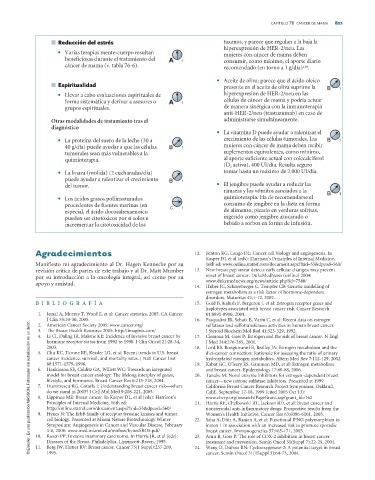Page 804 - medicina-integrativa_compress
P. 804
CAPÍTULO 76 CÁNCER DE MAMA 821
■ Reducción del estrés taxanos, y parece que regulan a la baja la
hiperexpresión de HER-2/neu. Las
• Varias terapias mente-cuerpo resultan
mujeres con cáncer de mama deben
beneficiosas durante el tratamiento del A A 1 consumir, como mínimo, el aporte diario
cáncer de mama (v. tabla 76-6). recomendado (en torno a 1 g/día) .
139
• Aceite de oliva: parece que el ácido oleico
■ Espiritualidad presente en el aceite de oliva suprime la B B 1
• Llevar a cabo evaluaciones espirituales de hiperexpresión de HER-2/neu en las
forma sistemática y derivar a asesores o A A 1 células de cáncer de mama y podría actuar
grupos espirituales. de manera sinérgica con la inmunoterapia
anti-HER-2/neu (trastuzumab) en caso de
Otras modalidades de tratamiento tras el administrarse simultáneamente.
diagnóstico
• La vitamina D puede ayudar a ralentizar el
• La proteína del suero de la leche (30 a crecimiento de las células tumorales. Las B B 1
40 g/día) puede ayudar a que las células B B 1 mujeres con cáncer de mama deben recibir
tumorales sean más vulnerables a la suplementos equivalentes, como mínimo,
quimioterapia. al aporte suficiente actual con colecalciferol
(D 3 activa), 400 UI/día. Resulta seguro
• La linaza (molida) (2 cucharadas/día) tomar hasta un máximo de 2.000 UI/día.
puede ayudar a ralentizar el crecimiento B B 1
del tumor. • El jengibre puede ayudar a reducir las
náuseas y los vómitos asociados a la B B 1
• Los ácidos grasos poliinsaturados quimioterapia. Ha de recomendarse el
procedentes de fuentes marinas (en consumo de jengibre en la dieta en forma
C 1
especial, el ácido docosahexaenoico de alimento, picado en verduras sofritas,
pueden ser citotóxicos por sí solos e ingerido como jengibre azucarado o
incrementar la citotoxicidad de los bebido a sorbos en forma de infusión.
Agradecimientos 12. Fenton RG, Longo DL: Cancer cell biology and angiogenesis. In
Kasper DL et al (eds): Harrison's Principles of Internal Medicine,
Manifiesto mi agradecimiento al Dr. Hagen Kennecke por su 16th ed: www.online.statref.com/document.aspx?fxid=55&dpcod=560/
revisión crítica de partes de este trabajo y al Dr. Matt Mumber 13. New breast pap smear detects early cellular changes; may prevent
por su introducción a la oncología integral, así como por su onset of breast cancer. DukeMedNews (online) 2004:
apoyo y amistad. www.dukemednews.org/news/article.php?id=7540/
14. Huber JC, Schneeberger C, Tempfer CB: Genetic modelling of
estrogen metabolism as a risk factor of hormone-dependent
disorders. Maturitas 42:1-12, 2002.
BIBLIOGRAFÍA 15. Gold B, Kalush F, Bergeron J, et al: Estrogen receptor genes and
haplotypes associated with breast cancer risk. Cancer Research
1. Jemal A, Murray T, Ward E, et al: Cancer statistics, 2005. CA Cancer 64:8891-8900, 2004.
J Clin 55:10-30, 2005. 16. Pasqualini JR, Schatz B, Varin C, et al: Recent data on estrogen
© Elsevier. Es una publicación MASSON. Fotocopiar sin autorización es un delito.
2. American Cancer Society 2005: www.cancer.org/ sulfatases and sulfotransferases activities in human breast cancer.
3. The Breast Health Resource 2005: http://imaginis.com/ J Steroid Biochem Mol Biol 41:323-329, 1992.
4. Li CI, Daling JR, Malone KE: Incidence of invasive breast cancer by 17. Clemons M, Goss P: Estrogen and the risk of breast cancer. N Engl
hormone receptor status from 1992 to 1998. J Clin Oncol 21:28-34, J Med 344:276-285, 2001.
2003. 18. Lord RS, Bongiovanni B, Bralley JA: Estrogen metabolism and the
5. Chu KC, Tarone RE, Kessler LG, et al: Recent trends in U.S. breast diet-cancer connection: Rationale for assessing the ratio of urinary
cancer incidence, survival, and mortality rates. J Natl Cancer Inst hydroxylated estrogen metabolites. Altern Med Rev 7:112-129, 2002.
88:1571-1579, 1996. 19. Kabat GC, O'leary ES, Gammon MD, et al: Estrogen metabolism
6. Hankinson SE, Colditz GA, Willett WC: Towards an integrated and breast cancer. Epidemiology 17:80-88, 2006.
model for breast cancer etiology: The lifelong interplay of genes, 20. Tanabe M: Novel enzyme inhibitors for estrogen-dependent breast
lifestyle, and hormones. Breast Cancer Res 6:213-218, 2004. cancer—new estrone sulfatase inhibitors. Presented at 1999
7. Dumitrescu RG, Cotarla I: Understanding breast cancer risk—where California Breast Cancer Research Project Symposium, Oakland,
do we stand in 2005? J Cell Mol Med 9:208-221, 2005. Calif., September 17-18, 1999 (cited 2005 Oct 13):
8. Lippman ME: Breast cancer. In Kasper DL, et al (eds): Harrison's www.cbcrp.org/research/PageGrant.asp?grant_id=162
Principles of Internal Medicine, 16th ed: 21. Harris RE, Chelbowski RT, Jackson RD, et al: Breast cancer and
http://online.statref.com/document.aspx?fxid=55&dpcod=560/ nonsteroidal anti-inflammatory drugs: Prospective results from the
9. Hynes N: The ErbB family of receptor tyrosine kinases and tumor Women's Health Initiative. Cancer Res 63:6096-6101, 2003.
cell biology. Presented at Miami Nature Biotechnology Winter 22. Saha A, Dhir A, Ranjan A, et al: Functional IFNG polymorphism in
Symposium: Angiogenesis in Cancer and Vascular Disease, February intron 1 in association with an increased risk to promote sporadic
4-8, 2006: www.med.miami.edu/mnbws/hynesSRO5.pdf/ breast cancer. Immunogenetics 57:165-171, 2005.
10. Rosen PP: Invasive mammary carcinoma. In Harris JR, et al (eds): 23. Arun B, Goss P: The role of COX-2 inhibition in breast cancer
Diseases of the Breast. Philadelphia, Lippincott-Raven, 1995. treatment and prevention. Semin Oncol 31(Suppl 7):22-29, 2004.
11. Berg JW, Hutter RV: Breast cancer. Cancer 75(1 Suppl):257-269, 24. Wang D, Dubois RN: Cyclooxygenase-2: A potential target in breast
1995. cancer. Semin Oncol 31(1Suppl 3):64-73, 2004.

